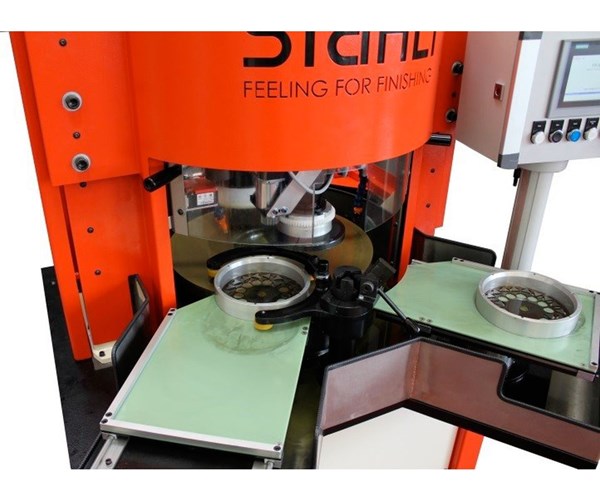Flat Honing Advances with In-Process Measurement
Single-sided machining with a grinding wheel now offers a more productive alternative to single-sided lapping and polishing processes. The key is an in-process measurement system that enables a flat honing machine to adjust wheel pressure automatically for consistent results.
Share






The FH-602 flat honing machine from Stahli can be automated to exchange carrier rings for continuous production.
Historically, single-sided abrasive machining was performed by lapping and polishing because fresh abrasive materials, such as silicon carbide, aluminum oxide or diamond, could be added while keeping the grinding pressure fixed. This approach enabled the process to create a consistent stock removal rate. According to Matt Huff and Timon Reamy, both part of the Stahli Lapping Technologies team (Lake Zurich, Illinois), single-sided abrasive machining with a grinding wheel now offers a more productive alternative.
They explain that flat honing (fine grinding) with planetary kinematics using cubic boron nitride (cBN) or diamond wheels is practical if variable pressure can be applied to adjust for dulling of the grinding wheel. Without means for this adjustment, a flat-honing machine cannot be operated solely by setting the grinding cycle time, because the stock removal rate will vary between grinding wheel sharpening intervals. Therefore, an in-process measurement system is needed so the machine control unit can increase pressure on the parts to compensate for a decline in the stock removal rate. By varying pressure, the grinding wheel can be held at the optimal sharpness point. This approach enables the wheel to be self-sharpening, thus minimizing the rate at which the wheel becomes dull. The newly released Stahli FH-602 machine now provides the necessary highly precise, highly accurate in-process measuring system for this process, the men say.
They add that Stahli Lapping Technologies offers grinding processes on the FH-602 series that are similar to the company’s larger DLM series of production machines. This development enables customers to run demanding and delicate operations on the machine. Depending on stock removal and surface finish requirements, as well as the consumables used, consistent results for 30 to 100 consecutive runs without any sharpening are achievable, they say.
The FH-602 machine uses an automatic size control system from SPS Industries (Farmington, Connecticut) with a touchscreen for entering and adjusting the process parameters. The grinding routine can be defined in multiple steps in which grinding force or removal rate can be controlled with freely selectable wheel turning speeds. The pressure head unit, which was developed and optimized over multiple generations, is one of the most important parts of the system, Mr. Huff and Mr. Reamy point out. It contains the micron-precise in-process system that measures the part thickness between the pressure plate and the grinding wheel. It also houses the stepless drive motor for the ring and pressure plate. Various hard and soft pressure plates are available to accommodate different workpiece materials.
Each batch of parts is placed in a carrier disc, which holds the parts in place inside the loading ring. One ring with a loaded carrier disc is ground at a time, while another ring can be prepared outside the machine. Rings of finished and unfinished parts can be exchanged manually or automatically, depending on how the module design of the machine is configured. Versions of the machine are available with fully covered stations for manual loading as well as stripped machines for integration in an automated cell.
According to Mr. Huff and Mr. Reamy, another important feature of the FH-602 series is the automatic sharpening and dressing station. It is positioned in the back of the machine opposite the grinding station. After a certain number of cycles or when a defined grinding time per cycle is reached, a sharpening and flushing sequence can be initiated manually or automatically. They also note that diamond and cBN grinding wheels can be used for single-sided flat honing with planetary kinematics in conjunction with precise in-process measurement. The efficiency of these superabrasive wheels expands the possibilities for this process and adds new applications within the manufacturing industry.
Related Content
Joint Ribbon Cutting at Fagor, Danobat Showrooms
Danobat and Fagor co-hosted an inaugural event for their co-located facilities in the Chicago area.
Read MoreStuder's Automation, Entry-Level Solutions Take Center Stage
At its 2024 Music Motion Meeting, Studer AG showed off its entry-level line of grinding machines, as well as its newest universal loading system.
Read MoreM&M Quality Grinding Bars Support High-Volume Production
PMTS 2025: M&M Quality Grinding provides precision grinding services for a variety of materials, including titanium, stainless steel, alloys and plastics.
Read MoreFacilitating Lean Manufacturing Through Modularity
Knowing how to subdivide machines and jobs has enabled Danobat to create a lean manufacturing process that improves its lead times by up to 25%.
Read MoreRead Next
Machine Shop MBA
Making Chips and 91±¬ÁĎÍř are teaming up for a new podcast series called Machine Shop MBA—designed to help manufacturers measure their success against the industry’s best. Through the lens of the 91±¬ÁĎÍř benchmarking program, the series explores the KPIs that set high-performing shops apart, from machine utilization and first-pass yield to employee engagement and revenue per employee.
Read MoreAMRs Are Moving Into Manufacturing: 4 Considerations for Implementation
AMRs can provide a flexible, easy-to-use automation platform so long as manufacturers choose a suitable task and prepare their facilities.
Read More





















